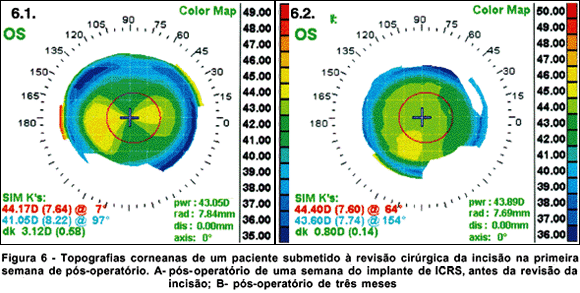PURPOSE: To evaluate the efficacy and safety of intrastromal corneal ring segments (ICRS) for the correction of low myopia, and to compare the obtained results with a control group submitted to laser in situ keratomileusis (LASIK). METHODS: Prospective, nonrandomized and bilateral study. Fourteen patients with preoperative spherical equivalent ranging from -1.00 to -4.50 D received ICRS in one eye and LASIK in the other. Postoperative evaluations were performed at day one and seven and months 1, 3, 6, 12 and 24. RESULTS: At the last follow-up, 64.29% of ICRS eyes (9/14) and 85.71% of LASIK eyes (12/14) were within ± 0.50 D of the predicted refractive outcome (p=0.385). Uncorrected visual acuity of 20/20 or better was observed in four of 14 ICRS eyes (28.57%), and in 12 of 14 LASIK eyes (85.71%) (p=0.002<a href="#nt02">²</a>). No variances of more than 1.00 D in the manifest spherical equivalent refraction between two consecutive examinations or significant loss of best spectacle-corrected visual acuity were observed in both groups. Surgically induced astigmatism was greater in ICRS eyes than in LASIK eyes. At 24 months, the ICRS eyes scored lower in contrast sensitivity testing, especially at higher spatial frequencies (p=0.032<a href="#nt02">²</a> at 18 cpd). The patients reported more subjective complaints in the early postoperative period for the ICRS eyes. CONCLUSIONS: ICRS were considered effective for the correction of low myopia, but their safety was limited by the observed surgically induced astigmatism, and their results were inferior compared to the control group.
Myopia; Cornea; Prosthesis implantation; Laser in situ keratomileusis; Myopia









